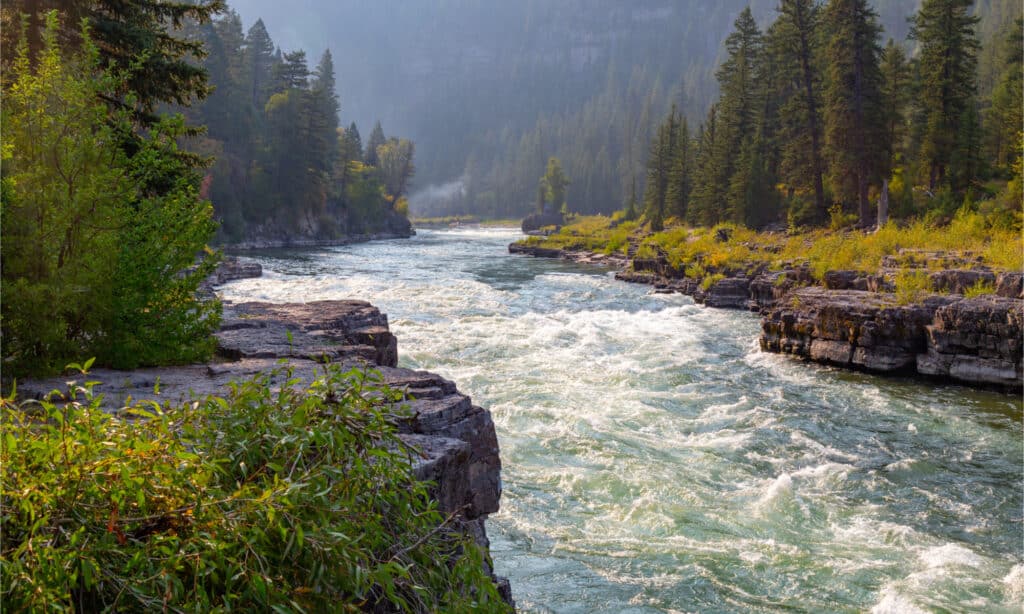Located in the Pacific Northwest, the Snake River is a major river in the United States. Beginning at its headwaters in Wyoming, the Snake River snakes and weaves its way through the countryside of the northwestern United States. In doing so, it crosses through Idaho, Oregon, and Washington before reaching the Columbia River. Then, mixed with water from other tributaries of the Columbia River, the Snake River finally reaches the Pacific Ocean. Its drainage basin can reach much further than the river itself, spreading into additional states such as Nevada and Utah.
This is just a brief overview of the Snake River, however. With a known history dating back thousands of years, there are many more interesting facts to explore about this river. Below, discover 5 interesting facts about the Snake River!
The Snake River is over 1,000 miles long!

One of the most interesting facts about the Snake River is its size!
©CSNafzger/Shutterstock.com
As a major river system, the Snake River is known for its great length. However, do you know just how long this river is? In its entirety, the Snake River measures an estimated 1,078 miles in length. The river it is connected to, which will be discussed more later below, is the largest North American river that deposits into the Pacific Ocean.
With hundreds of miles making up this river, there are ample opportunities for it to branch off. As a result, it has over a dozen notable tributaries. This includes the Salt River in Wyoming and the Malad River in Idaho. Because the Snake River is so long, these tributaries and where they connect with the main river are helpful in identifying the different segments of the river. The longest tributary of the Snake River is the Salmon River.
It is the largest tributary of the Columbia River.

The Snake River is the largest tributary of the Columbia River.
©Barry Bjork/Shutterstock.com
As mentioned above, the Snake River is connected to the largest North American river with Pacific Ocean connections: the Columbia River. The Columbia River is the largest river in the Pacific Northwest, measuring 1,243 miles in length. Not only does the Snake River connect to the Columbia River, but it is also the largest tributary of the Columbia River!
The Snake River has a basin size of 108,000 square miles. This expands into several states, even though they do not home the river itself.
Millions of salmon spawn in Snake River.

Salmon end their lives by traveling upstream to their birthplaces to spawn.
©cweimer4/iStock via Getty Images
There are many interesting facts about the Snake River that revolve around salmon. Historically, the Columbia River, and thus the Snake River, were known to be the world’s most abundant habitat for salmon.
Though there are various different species of salmon, they share a unique characteristic. First, they are born in freshwater. As they mature, they follow the river into the ocean to live in brackish and saltwater. Then, when it comes time for them to spawn again, they will swim upstream to return to the river where they were born. In the past, for millions of individual salmon, their birthplace lay in the Columbia River and the Snake River. This is especially true for species like the Snake River sockeye salmon or the Chinook salmon.
Today, however, many of the salmon species that once called the Snake River home face extinction, though the exact endangered classification varies. The Chinook salmon of the Snake River are threatened, while the Snake River sockeye salmon are endangered because of this; numbers that once sat well into the millions now sit in the tens of thousands at best.
In an effort to save the salmon species that live here, many changes have been made to the river in recent decades. This includes the removal of several dams to allow salmon access to greater upstream habitats.
Several different species are endemic to the Snake River.

The Snake River is home to hundreds of native species.
©iStock.com/Maxvis
There are at least four different species of fish endemic to the Snake River. An endemic species is one that lives in only a single specific location in the world. These species, found below Shoshone Falls, include the:
- Relict sand roller (Percopsis transmontana)
- Shorthead sculpin (Cottus confusus)
- Marginated sculpin (Cottus marginatus)
- Oregon chub (Oregonichthys crameri).
However, endemic species aren’t the only native fish to populate Snake River. Instead, there are 35 recorded native fish species.
Over 250 species of birds live in the Snake River watershed.

Because of conservation areas and the natural size of the Snake River, hundreds of birds live and nest in this region.
©wendy blanchard/Shutterstock.com
When thinking about a river, it is common to think only about the aquatic species that live there. However, many terrestrial animals also rely on the Snake River. This includes over 250 different species of birds! The Morley Nelson Snake River Birds of Prey National Conservation Area (NCA) is home to one of the densest populations of nesting raptors, such as eagles and owls.
The photo featured at the top of this post is © Ansel B/Shutterstock.com
Thank you for reading! Have some feedback for us? Contact the AZ Animals editorial team.







